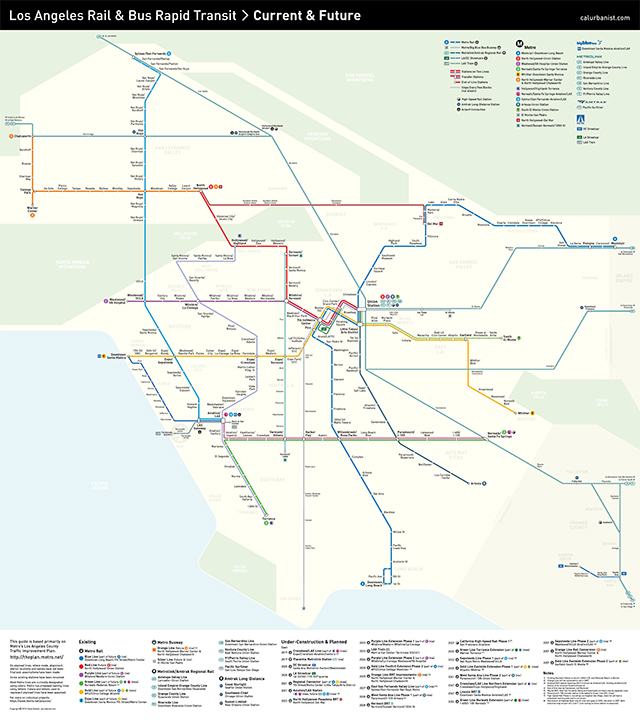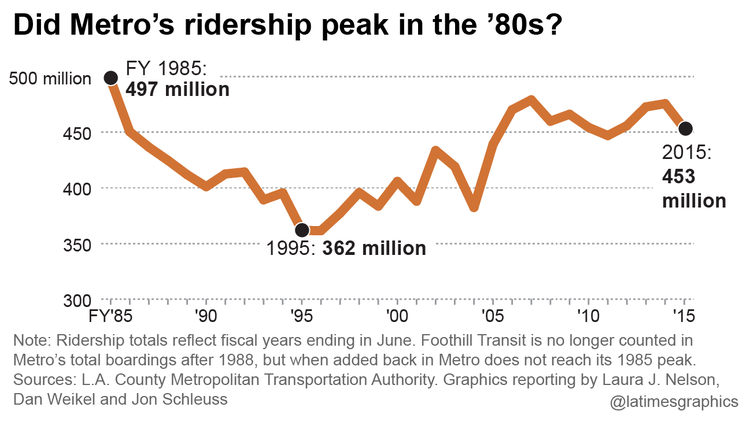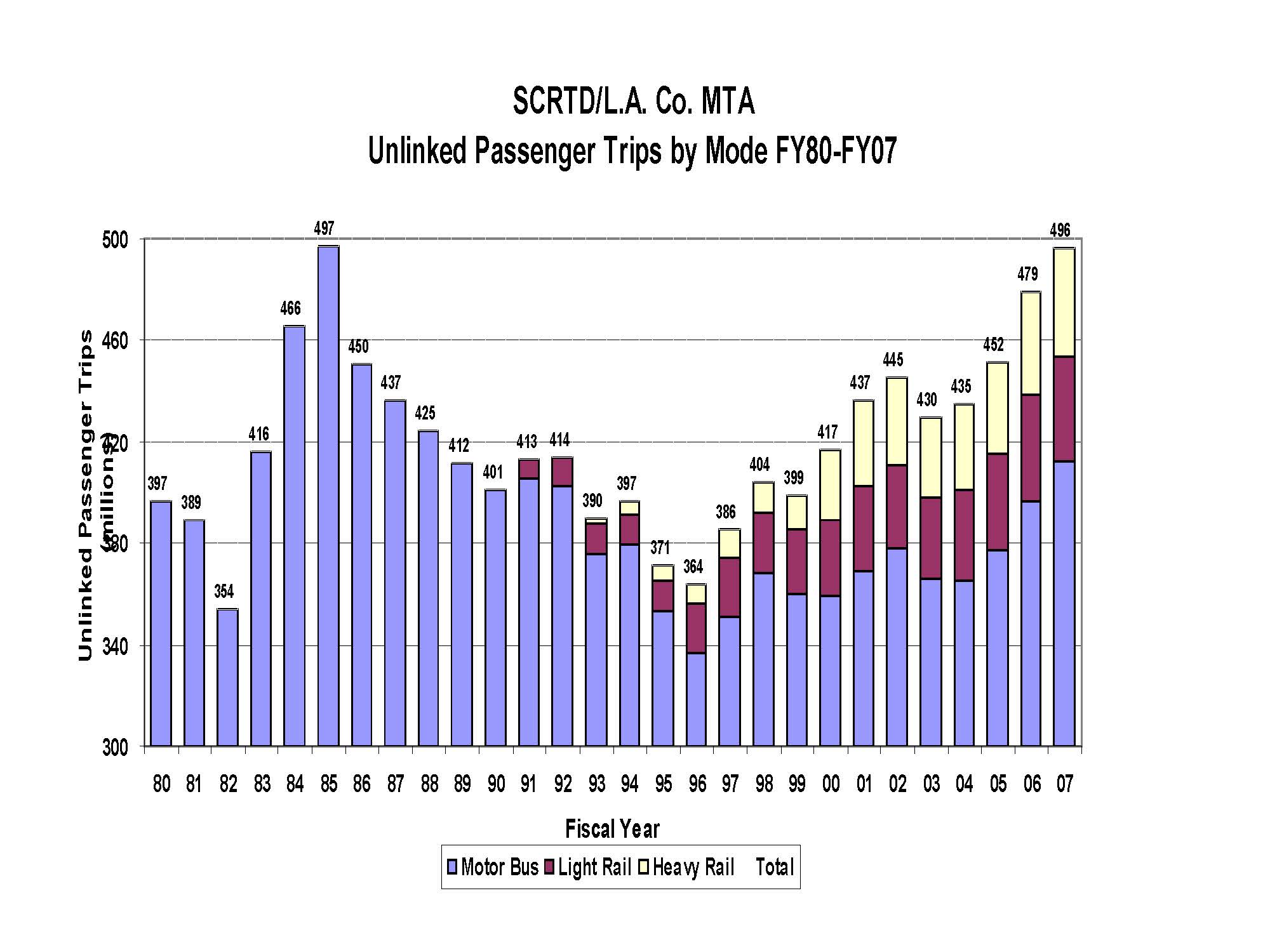What started with Proposition A in 1980, continued with Proposition C in 1990, and then bolstered with Measure R in 2008, will now be tested once again officially as Measure M in November. I’m talking of course about Los Angeles rail transit plans, which once again hinge on another voter-approved sales tax measure.
The measure promises a host of new transit plans for the region, as illustrated with this map as a side project from a Nelson/Nygaard employee:
A few notable things stand out about this measure. First, there is no sunset date, which is a departure from Measure R’s 30-year limit. The justification is that the measure includes operating funds for transit, which address a need that doesn’t sunset.
Second, the new projects cover some vital links in the region, most prominently a public-private toll road and rail tunnel connection from the Westside to the Valley underneath the Sepulveda Pass. It also includes rapid bus down the high transit-usage Vermont Avenue and Lincoln Boulevard along the coast and connections to the eastern part of the county (including the gap between the Green Line in Norwalk and the Metrolink station).
There will be a battle royale to try to surmount the two-thirds voter approval hurdle this November, and the plan clearly contains a lot for every part of the county, including some unfortunate projects (the “High Desert Corridor” freeway stands out as particularly egregious). But it’s hard to blame Metro for trying again, given the success in 2008 and near-miss in 2012 with Measure J, along with the scale of the need.
There’s a lot of hand-wringing in transit circles in Los Angeles today, as the Los Angeles Times just ran a piece documenting the decline in transit ridership in Los Angeles, despite some big investments in rail:
The Los Angeles County Metropolitan Transportation Authority, the region’s largest carrier, lost more than 10% of its boardings from 2006 to 2015, a decline that appears to be accelerating. Despite a $9-billion investment in new light rail and subway lines, Metro now has fewer boardings than it did three decades ago, when buses were the county’s only transit option.
The article notes that the trend is happening nationwide and suggests multiple factors at play, such as “a changing job market, falling gas prices, fare increases, declining immigration and the growing popularity of other transportation options, including bicycling and ride-hailing companies such as Uber and Lyft.”
While the article highlights an important issue and puts it in a nationwide context, reporters Laura Nelson and Dan Weikel presented some misleading figures on Los Angeles ridership patterns. It starts with this graph illustrating the decline:
The problem with the graph is that the reporters are cherry-picking the absolute high water mark of transit ridership in Los Angeles.
As I describe in the book Railtown, Los Angeles County voters approved a sales tax measure in 1980 that not only launched the rail system in L.A., it kept bus fares to 50 cents for three years. That reduction in fares sparked a temporary and significant spike in ridership, as this graph of ridership from 1980 to 2007 illustrates:
So choosing 1985 as your baseline is like climate change deniers choosing an unusually warm year in the 1990s to show that global warming hasn’t really been happening since then.
In addition, the article is a bit unfair to Metro in citing the billions of dollars that have been invested in rail during this period of declining ridership. Sure, since 2006 the region has been spending a lot of money on rail, but those investments have not yet resulted in actual, open rail lines. Since that year, only the East Side Gold Line and half of the Expo Line (to Culver City) have opened.
Meanwhile, Expo to Santa Monica and the Gold Line extension to Azusa are on deck to open this year, while Crenshaw, the downtown Regional Connector and the subway extension down Wilshire are all under construction. Once they open, the region will only then see the true return on that investment.
I’m certainly glad that the Times is highlighting this important issue, and I’m hopeful it will spark calls to address it. One easy way to do so would be to lower fares, as the 1980s experience proves. Another way would be to build a lot more jobs and housing near rail transit stations, as we’ve documented in a recent report from Berkeley Law and Next 10.
But we shouldn’t let reports like these undermine the case for finishing the job of building out L.A’s rail system. The region is only halfway done, and with these new projects under construction and more attention paid to the station neighborhoods, the ridership numbers will surely increase from this temporary — albeit disheartening — setback.
Zocalo really covered it all with me for a Q&A before my talk on rail last November in Los Angeles. Most relevant for an environmental blog:
Q: What’s the quickest way to dispel climate change deniers?
A: I usually talk about all the positive things, and try to shift the debate away from science—energy independence, the fun of driving an electric vehicle, the fun of kissing your gas station goodbye, more local jobs. I try to go to the positives that we would get in our society if we could switch out of dirty fuels. It’s more disarming the deniers rather than getting in a debate. My basic philosophy is you can never convince anyone of anything.
Since I confessed in the interview to having a Richard Nixon impersonation, this might be a good time to list my top three favorite Nixon quotes:
“You won’t have Nixon to kick around anymore, because, gentlemen, this is my last press conference.”
“People have got to know whether or not their president is a crook. Well, I’m not a crook. I earned everything I’ve got.”
“When the President does it, that means that it’s not illegal.”
My wife just visited the Nixon Library in Orange County for a research project, and she told me the place has giant Nixon quotes on the wall. None could be as good as these three.
Today at noon in the LA area I’ll be on Larry Mantle’s AirTalk program, 89.3 FM (KPCC public radio). Joining me for the hour-long segment will be Art Leahy, CEO of LA Metro, and we’ll be discussing the past, present and future of LA Metro Rail. I imagine I’ll be speaking mostly about what I’ve learned in researching and writing my book Railtown, so it should be fun to have Mr. Leahy there to respond. Join if you can, and I’ll post the link after it airs.
UPDATE: The link to the audio, along with a page for commenting, can be found here.





